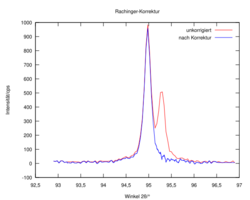Physics:Rachinger correction
This article provides insufficient context for those unfamiliar with the subject. (April 2019) (Learn how and when to remove this template message) |
The Rachinger correction is a recursive method suggested by William Albert Rachinger (1927) to eliminate the disturbing [math]\displaystyle{ K_{\alpha_2} }[/math] peak from X-ray diffraction.[1]
Cause of the double peak
For diffraction experiments with X-rays radiation is usually used with the [math]\displaystyle{ K_\alpha }[/math] Wavelength of the anode material . However, this is a doublet, so in reality two slightly different wavelengths. According to the diffraction conditions of the Laue or Bragg equation, both wavelengths each generate an intensity maximum. These maxima are very close to each other, with their distance depending on the diffraction angle [math]\displaystyle{ 2\theta }[/math]. For larger angles, the distance of the intensity maxima is greater.
Procedure
Basics
The wavelengths of [math]\displaystyle{ K_{\alpha_1} }[/math] and [math]\displaystyle{ K_{\alpha_2} }[/math] radiation are also known to increase their energy through the relationship:
[math]\displaystyle{ E = h \frac{c_0}{\lambda} }[/math]
From this, the angular distance can be determined for each diffraction angle [math]\displaystyle{ \Delta\theta }[/math] determine the two Kα peaks.
Furthermore, it is known how the intensities of [math]\displaystyle{ K_{\alpha_1} }[/math] and [math]\displaystyle{ K_{\alpha_2} }[/math] behave in the diffraction pattern. This ratio is determined quantum mechanically and is for all anode materials:
[math]\displaystyle{ r = \frac{I_{\alpha_2}}{I_{\alpha_1}} = 0.5 }[/math]
Calculation
The total intensity is:
[math]\displaystyle{ I(\theta) = I_1(\theta) + I_2(\theta) }[/math],
where [math]\displaystyle{ I_1(\theta) }[/math] is the intensity of the pure [math]\displaystyle{ K_{\alpha_1} }[/math] peak and [math]\displaystyle{ I_2(\theta) }[/math] the intensity of the pure [math]\displaystyle{ \alpha_2 }[/math] peak.
The intensity of [math]\displaystyle{ K_{\alpha_2} }[/math] peak can be expressed as:
[math]\displaystyle{ I_2(\theta) = r\cdot I_1(\theta-\Delta\theta) }[/math],
so the overall intensity is:
[math]\displaystyle{ I(\theta) = I_1(\theta) + r\cdot I_1(\theta-\Delta\theta) }[/math]
Practical Implementation
To practically perform the Rachinger correction, one starts on a rising edge of a peak. For a certain angle [math]\displaystyle{ \theta }[/math] becomes the intensity of the diffraction image [math]\displaystyle{ I(\theta) }[/math] take and with [math]\displaystyle{ r }[/math] scales with [math]\displaystyle{ I'(\theta) = r\cdot I(\theta) }[/math], at the same time the angle difference becomes te calculated [math]\displaystyle{ \Delta\theta }[/math]. At the point [math]\displaystyle{ \theta+\Delta\theta }[/math] can the true intensity [math]\displaystyle{ I_1 }[/math] (which, if there is no [math]\displaystyle{ K_{\alpha_2} }[/math]peak) would be calculated by: [math]\displaystyle{ I_1(\theta+\Delta\theta) = I(\theta+\Delta\theta) - I'(\theta) }[/math].
Since the measured values of X-ray diffraction experiments are usually available as ASCII tables, this procedure can be repeated step by step until the entire diffraction pattern has been run through.
Today this method is hardly used anymore. Due to the power of the computer, the [math]\displaystyle{ K_{\alpha_2} }[/math] peak (einfach immer mitgefittet??).
Restrictions
From the way the corrected diffraction image is calculated, it follows that no correction is made for the small diffraction angles. Furthermore, the assumption Rachinger that it is [math]\displaystyle{ K_{\alpha_2} }[/math] Peak just a scaled variant of the [math]\displaystyle{ K_{\alpha_1} }[/math] peaks are not correct, as the lines generally have different widths.[2] Therefore, in reality there is a deviation in form and intensity. Also, the correction loses its validity for a non-negligible background, since this itself causes an unwanted correction.
Literature
- Rachinger, William Albert (1948). "A Correction for the α1 α2 Doublet in the Measurement of Widths of X-ray Diffraction Lines". Journal of Scientific Instruments 7 (25): 254–255.
- {{cite book
|last= Warren |first=B. E. |date=1969 |title=X-ray Diffraction |url= |location= |publisher=Dover Publications |page= |isbn=0-486-66317-5
References
- ↑ Brent Fultz; James Howe (29 June 2013). Transmission Electron Microscopy and Diffractometry of Materials. Springer Science & Business Media. p. 706. ISBN 978-3-662-04901-3. https://books.google.com/books?id=J4nqCAAAQBAJ&pg=PA706. Retrieved 5 April 2019.
- ↑ Krause, M. O.; Oliver, J. H. (1979). "Natural widths of atomic K and L levels, Kα X-ray lines and several KLL Auger lines". Journal of Physical and Chemical Reference Data 8: 329–338.


